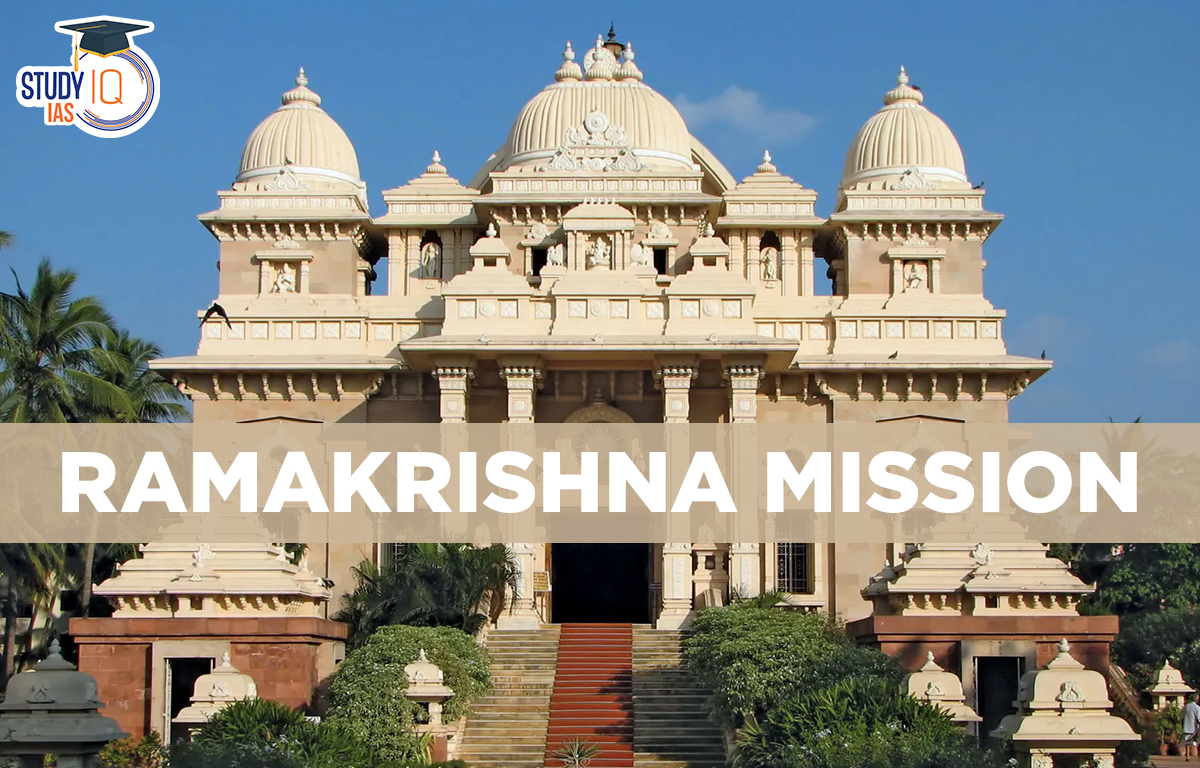Table of Contents
The Ramakrishna Mission is a spiritual and philanthropic organization founded by Swami Vivekananda on 1 May 1897. It was established in honor of his guru, Ramakrishna Paramahamsa, to serve humanity through spiritual and social endeavors. The mission continues to play a vital role in uplifting society and spreading the teachings of Vedanta.
Ramakrishna Mission
The Ramakrishna Mission, often referred to as the Vedanta Movement is centred on the Hindu religious and spiritual organization known as the Ramakrishna Mission. The mission is named after and inspired by the Indian spiritual leader Ramakrishna Paramahamsa and was founded on May 1, 1897, by Swami Vivekananda, who was Ramakrishna Paramahamsa’s primary disciple.
The organization’s main causes are the Hindu philosophy of Advaita Vedanta and the four yogic precepts of Jnana, Bhakti, Karma, and Raja yoga. You will learn about the Ramakrishna Mission in this article, which will aid with your preparation for the UPSC Civil Service Exam.
Read More: Young Bengal Movement
Ramakrishna Mission History
Founding
The Ramakrishna Mission was founded shortly after Swami Vivekananda’s return from the West, where he gained international recognition at the Parliament of Religions in Chicago in 1893. Inspired by his guru Ramakrishna’s teachings, Vivekananda envisioned an organization that would combine spiritual pursuits with social service.
Early Years
In its early years, the mission focused on spiritual teachings, education, and relief work. The Ramakrishna Math, a monastic order, was established alongside the mission to provide a spiritual foundation for its activities. The mission’s headquarters was set up at Belur Math, near Kolkata, which remains its central hub to this day.
Ramakrishna Mission Features
Spiritual Activities
- Preaching and Teaching: The mission conducts regular spiritual discourses, meditation sessions, and yoga classes to promote self-awareness and spiritual growth.
- Publication of Literature: The mission publishes books, journals, and magazines that disseminate the teachings of Vedanta and the life stories of Ramakrishna, Swami Vivekananda, and other spiritual leaders.
Educational Initiatives
- Schools and Colleges: The mission runs numerous educational institutions across India, providing quality education to students from all backgrounds.
- Vocational Training: Special emphasis is placed on vocational training to empower individuals with practical skills for self-reliance.
Healthcare Services
- Hospitals and Clinics: The mission operates hospitals, dispensaries, and mobile health units, offering medical care to the underprivileged.
- Health Camps: Regular health camps are organized to address the healthcare needs of rural and remote areas.
Social Welfare
- Relief Work: The mission is actively involved in disaster relief operations, providing aid to victims of natural calamities such as floods, earthquakes, and cyclones.
- Welfare Programs: Various welfare programs are conducted to support the poor, including orphanages, old-age homes, and rehabilitation centers.
Ramakrishna Mission Significance
Spiritual and Social Harmony
The Ramakrishna Mission exemplifies the harmonious blend of spiritual growth and social service. Its activities reflect the ideals of selfless service, compassion, and universal brotherhood, as taught by Swami Vivekananda and Ramakrishna Paramahamsa.
Educational Impact
The mission’s educational initiatives have significantly contributed to the intellectual and moral development of countless individuals. By providing access to quality education, the mission empowers the youth to become responsible and enlightened citizens.
Healthcare Contributions
Through its extensive healthcare services, the mission addresses the pressing medical needs of underprivileged communities. Its commitment to holistic well-being ensures that both physical and spiritual health are nurtured.
Disaster Relief and Social Welfare
The Ramakrishna Mission’s prompt and effective response to disasters has saved countless lives and provided much-needed relief to affected communities. Its social welfare programs continue to uplift the marginalized and promote social equity.
Ramakrishna Mission and Ramakrishna Parmahamsa
Poor Brahmin priest Gadadhar Chattopadhyaya later became renowned as Ramakrishna Paramahamsa. Sri Ramakrishna was born on February 18th, 1836, into a humble Brahmana family in the Bengali village of Kamarpukur. His father, Khudiram Chatterjee, was a man of great piety and moral integrity. His mother Chandramani Devi served as an example of strong female characteristics.
His official education in Shastras or philosophy was nonexistent, and he only completed the first grade of school. Ramakrishna was a priest of the Dakshineswar Kali Temple who attracted a sizable following of laypeople and monks. By comprehending the Hindu epics, imitating India’s great spiritual principles by hearing scholars recite and explain them, and, most importantly, by going directly to Nature to study people and things, he educated himself in a deeper way.
Ramakrishna Paramahamsa’s wife and spiritual companion was Sarada Devi. Ramakrishna Paramahamsa’s most devoted student, Narendra Nath Datta (1863–1902), afterwards known as Swami Vivekananda, disseminated Ramakrishna’s teachings throughout the world, particularly in America and Europe. After Ramakrishna’s passing on Christmas Eve in 1886, the youthful adherents made informal monastic vows.
Ramakrishna Mission UPSC
In addition to providing religious and spiritual teaching, the organization engages in extensive educational and social work both in India and abroad. This trait was also adopted by many other Hindu tribes. The mission’s work is built on karma yoga principles, which are those of selfless service to God. A large number of important Hindu works are published by the Ramakrishna Mission, a global institution. It is connected to a monastic group. Vivekananda’s guru (teacher), Ramakrishna, had a profound influence on him.


 Birsa Munda Birth Anniversary 2025: Life...
Birsa Munda Birth Anniversary 2025: Life...
 Military Innovations of Afghans and Turk...
Military Innovations of Afghans and Turk...
 Self-Respect Movement, History, Objectiv...
Self-Respect Movement, History, Objectiv...

























